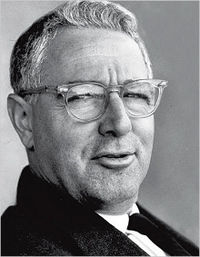 Born in Maryland in 1913, Karl Shapiro was one of the youngest recipients of the Pulitzer Prize and was famous for denigrating his university in Virginia as a place where both blacks and Jews were treated with disdain. Shapiro’s early work was stoutly traditionalist but he quickly fell out of love with it, believing that it eventually stifled the creativity of the writer.
Born in Maryland in 1913, Karl Shapiro was one of the youngest recipients of the Pulitzer Prize and was famous for denigrating his university in Virginia as a place where both blacks and Jews were treated with disdain. Shapiro’s early work was stoutly traditionalist but he quickly fell out of love with it, believing that it eventually stifled the creativity of the writer.
Shapiro went to Virginia State University and then onto John Hopkins before war broke out in 1939. He began to publish his poetry whilst he was stationed in New Guinea, writing poignant verses and then sending each home. Collected together they formed collections of some of his most popular early works such as Person, Place, and Thing that was published in 1942 and Essay on Rime that came out towards the end of the war.
V-Letter and Other Poems, published in 1945, earned him the Pulitzer Prize. This collection explored how soldiers tried to reconcile notions of normal life back home with the intensity and tragedy that made up their everyday lives in war. V-letters were written by soldiers during the war and then transferred onto microfilm to be transported back to the US en masse. In 1946, Shapiro was granted the honor of becoming the 5th Poet Laureate for the US.

With the war over, Shapiro settled to life as an editor for the Poetry magazine before joining the University of Nebraska, editing the influential literary magazine Prairie Schooner which published many leading poets of the day including William Carlos Williams.
He was not free of controversy over these years. When the Bollingen Prize was going to be given to poet Ezra Pound, Shapiro offered harsh objections on account of the man’s anti-Semitic views. He later said that it was a turning point for him in that he had to finally stand up and be counted as a Jew rather than just a poet, particularly when it made front page news.
In 1958 he published the collection Poems of a Jew which he said explained his view as an outsider who was never really accepted. It also included his poem about Virginia State University and its treatment of anyone who was different, whether they were Jewish or Black-American. By this time Shapiro was beginning to experiment with different forms and, like his influences Walt Whitman and the Beat poets, he broke new ground in his 1964 collection The Bourgeois Poet which shocked critics with its apocalypse laden tone.
Shapiro moved from the University of Nebraska to California in 1968 where he took up a post at the university there, staying until his retirement in 1985. In 1969 he won the Bollingen Prize he had previously denied Ezra Pound. He wrote several collections over the years, including White-Haired Lover and Love and War, Art and God as well as some autobiographical prose works.

Karl Shapiro died in 2000 at the age of 87. His last work, Coda: Last Poems, was from a collection of poems found by his wife in the drawer of his desk two years after his death.

